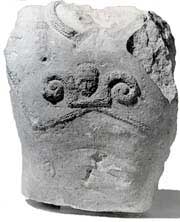- Home
- Research and interpretations
- History of excavation
- During the German occupation
The site in 1943: military buildings, location of the statuary
The most famous episode in the modern history of the site occurred in June 1942 when German troops invaded the “free zone” and occupied southern France. During this year, the plateau of Entremont was inhabited by a military camp with barracks surrounding a DCA post.
At two different occasions within one month, terracing work resulted in the unearthing of four heads, two torsos and numerous statue fragments. The first discoveries were made on the 20-23 May 1943 by the Duran company of Aix, which was hired by the German authority.
The second discovery was made on June 12 by German soldiers digging a posthole. The question of ownership was immediately raised due to the recent passing of a law concerning discoveries (1941). The property was shared between the discoverer and the land owner, Madame Jourdan.
After the departure of the occupation troops, Fernand Benoit, director of antiquites, took stock of the situation of the plateau in October 1944. Photographs enhanced his descriptions of the houses and allowed him to situate the discoveries of statues during the Occupation.
But the future of the statuary stored at the Duran warehouse rapidly raised heated questions.
Would it go to the museum of Arles? Would the Germans claim their right to it? Where would it be presented to the public? One female head that had already disappeared was said to have been sold by a worker to an antiquarian from Aix.
On the 20th of June, it was estimated that the work of installing a foundation and septic tank for toilets would last four weeks. Colonel Dr. Möbius, of the service of Beaux-Arts of the German military government in France, obtained a French safe-conduct who would supervise the work and could be accompanied by one person. For this job, Marcel Provence proposed Jean Boyer, his assistant conservator at the Museum of Tapestries and municipal archivist and librarian at Méjanes. Fernand Benoit was authorized to accompany him.
Torso with a decorative clasp and decapitated head found in 1943.


